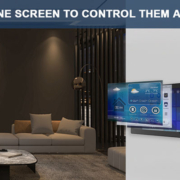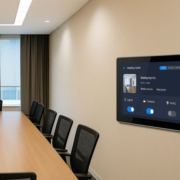Loxone Smart Home System and Its Perfect Integration with Portworld Control Panels
1. What is Loxone?
Loxone is an Austrian brand specializing in smart home and building automation solutions. Since its founding in 2009, Loxone has become a trusted name in over 100 countries, known for its Miniserver central controller and comprehensive software ecosystem.
The company’s philosophy is “automation first” — integrating lighting, HVAC, shading, security, audio-visual, and energy management into one unified platform to achieve true “one-touch scenes” and full automation.
Key features of the Loxone system:
- Miniserver core controller: Handles logic processing, protocol conversion, and device control.
- Multi-protocol compatibility: Supports KNX, Modbus, RS485, HTTP API, Zigbee (via gateway), and more.
- Visualization & app control: Offers mobile apps, touch panels, and web interfaces.
- High stability: Operates locally without relying on cloud services, ensuring privacy and real-time responsiveness.
- Versatile applications: Ideal for homes, villas, hotels, offices, and commercial buildings.
2. Portworld’s Role and Advantages
Portworld is a manufacturer focused on smart touch control panels, industrial tablets, and embedded boards. Its products cover Android, Linux, and Windows platforms and support OEM/ODM customization, serving industries like smart homes, building control, industrial automation, and retail.
Key advantages of Portworld control panels:
- Highly customizable: Screen sizes (5.5″–21.5″), design, and interface layout can be tailored for projects.
- Multi-protocol support: Built-in RS485, Ethernet, Wi-Fi, and Bluetooth for KNX, Modbus, HTTP API, and more.
- Flexible system options: Supports installing Android apps (such as the Loxone App) or embedding web-based visualization interfaces.
- Industrial-grade quality: 24/7 operation capability, with PoE (Power over Ethernet) options for commercial and high-end residential use.
3. How Loxone and Portworld Work Together
Loxone provides the control logic and system backend, while Portworld offers the front-end hardware for touch and visualization. Together, they form a complete smart home or building automation solution.
Integration examples:
-
Portworld smart home control panels as Loxone HMIs (Human-Machine Interfaces)
- Install the Loxone App on Portworld Android panels or use the built-in browser to access Loxone’s web interface.
- Wall-mounted displays replace or complement Loxone Touch Surfaces, offering larger screens and richer visualization.
-
Direct protocol connection
- Portworld hardware can connect to Loxone’s Miniserver via RS485 or Ethernet, supporting Modbus, HTTP API, and other protocols.
- For direct KNX integration, Portworld panels can include a KNX interface or connect through a gateway.
-
Project-based customization
- For large-scale villa or commercial projects, Loxone handles automation logic while Portworld supplies multiple sizes and designs of customized panels to fit different rooms and spaces.
-
Hybrid system deployment
- In mixed systems (e.g., KNX + Loxone + other brands), Portworld smart home control panels can serve as a unified interface, consolidating control into a single touch display.
4. Application Scenarios
- Luxury residences: Loxone manages lighting, shading, and HVAC logic; Portworld panels provide an elegant wall-mounted interface for control and status display.
- Hotels & offices: Loxone handles backend device management and scheduling; Portworld delivers guest room or meeting room touch terminals.
- Commercial complexes: Loxone oversees energy and security management; Portworld panels act as control and information display terminals.
Loxone and Portworld are complementary, not competing.
- Loxone = Stable and powerful backend control & automation logic.
- Portworld = Flexible, customizable front-end touch and display hardware.
Combined, they offer a complete, end-to-end automation solution — from backend intelligence to user-friendly control — making smart home and building automation projects more efficient, elegant, and easy to operate.








